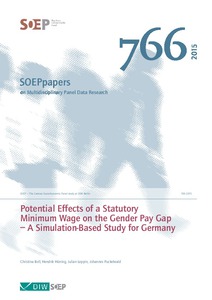Potential effects of statutory minimum wage on the gender pay gap: a simulation-based study for Germany
"In a simulation-based study with data from the German Socio-Economic Panel Study (SOEP), we analyze the effects of the newly introduced statutory minimum wage of 8.50 Euro per working hour in Germany on the gender wage gap. In our first scenario where we abstain from employment effects, the pa...
| Main Authors: | , , , |
|---|---|
| Institution: | ETUI-European Trade Union Institute |
| Format: | TEXT |
| Language: | English |
| Published: |
Berlin
2015
DIW |
| Subjects: | |
| Online Access: | https://www.labourline.org/KENTIKA-19111906124919391889-Potential-effects-of-statutory.htm |
| Summary: | "In a simulation-based study with data from the German Socio-Economic Panel Study (SOEP), we analyze the effects of the newly introduced statutory minimum wage of 8.50 Euro per working hour in Germany on the gender wage gap. In our first scenario where we abstain from employment effects, the pay differential is reduced by 2.5 percentage points from 19.6 % to 17.1 %, due to a reduction of the sticky-floor effect at the bottom of the wage distribution. In more realistic scenarios where we incorporate minimum wage effects on labor demand, a further reduction of the pay gap by 0.2 pp (1.2 pp) in case of a monopsonistic (neoclassical) labor market is achieved. However, this comes at the cost of job losses by which women are more strongly affected than men. The magnitude of job losses ranges be-tween 0.2 % and 3.0 % of all employees. It is higher in a neoclassical market setting and positively related to the assumed wage elasticity." |
|---|---|
| Physical Description: | 43 p. Digital |

